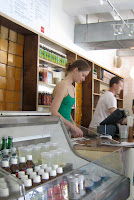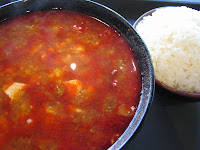Cuisine
Kuku Canteen
 In the interest of full disclosure, it should be noted that I have a relationship with the restaurant featured in this review: The folks at Wawa Canteen prepare delicious food, and I eat it. Several times a week.
In the interest of full disclosure, it should be noted that I have a relationship with the restaurant featured in this review: The folks at Wawa Canteen prepare delicious food, and I eat it. Several times a week.
When a tiny Korean restaurant in central Greenwich Village closed a couple years back, neighbors were dismayed, expecting the usual NYU-geared smoothie/creperie/coffee shop to open in its place. But what arrived was Korean Restaurant 2.0, with a sleek design comprised of wood counters flanked by modern chairs, tiled walls and floors, and displays of rice and Sapporo lining the back wall. It’s now owned by Philip Rodrigue, who used to own the Cooler in the MPD. (He brought his excellent music collection with him.) What a relief to have an actual restaurant in this spot, and an approachable one, too. The ergonomic layout allows for quick service, because, as Rodrigue puts it, “You ought to be able to eat some decent food for $10 and be in and out in a half hour.”
Eureka. It’s the concept of a diner applied to ethnic food, in this case, Korean cuisine, which is underrepresented in New York compared to the plethora of Chinese, Japanese, and pan-Asian spots. Though Rodrigue says he was going for “generic eating,” the results are anything but. Consulting chef Donna Lee put a California spin on Korean food with home-cooking style dishes like surprisingly light kimchi fried rice.
 My first feeling upon biting into the kimchi fried rice with chicken was one of deep regret. Here I’d been eating at Wawa Canteen for nearly two years, and I’d never tried the best dish on the menu until now, in my quest to cover as many items as possible. The kimchi is so good – spicy, sweet, crunchy, tangy – and the sticky, fluffy rice has chili flecked throughout. Though this is traditional home cooking, the type you won’t find in Koreatown restaurant-style food, the presentation is elegant, with fine strips of nori on top. It’s exciting comfort food, and it can be habit-forming.
My first feeling upon biting into the kimchi fried rice with chicken was one of deep regret. Here I’d been eating at Wawa Canteen for nearly two years, and I’d never tried the best dish on the menu until now, in my quest to cover as many items as possible. The kimchi is so good – spicy, sweet, crunchy, tangy – and the sticky, fluffy rice has chili flecked throughout. Though this is traditional home cooking, the type you won’t find in Koreatown restaurant-style food, the presentation is elegant, with fine strips of nori on top. It’s exciting comfort food, and it can be habit-forming.
 Kimchi is an insanely popular ingredient here: during the NYU school year, Wawa goes through four 15-gallon vats of it in a week. Like a new pickle, Wawa’s kimchi retains that vegetable crunch that enlivens so many of the dishes here. The soft, barely sweet dough of the kimchi pajun is interlaced with strips of this crispy goodness, all of which goes beautifully with the slightly vinegary soy sauce.
Kimchi is an insanely popular ingredient here: during the NYU school year, Wawa goes through four 15-gallon vats of it in a week. Like a new pickle, Wawa’s kimchi retains that vegetable crunch that enlivens so many of the dishes here. The soft, barely sweet dough of the kimchi pajun is interlaced with strips of this crispy goodness, all of which goes beautifully with the slightly vinegary soy sauce.
 Of course, what kimchi also does is heat things up. Only the intrepid should opt for the kimchi stew, an incredibly spicy, sour concoction that blows away neighboring faux-Asian places whose food has too much sugar and not enough heat.
Of course, what kimchi also does is heat things up. Only the intrepid should opt for the kimchi stew, an incredibly spicy, sour concoction that blows away neighboring faux-Asian places whose food has too much sugar and not enough heat.  A red slick of chili oil on the soft tofu stew tells you this is one seafood dish that shouldn’t be taken lightly. Thankfully, the white rice served alongside helps put out the flames.
A red slick of chili oil on the soft tofu stew tells you this is one seafood dish that shouldn’t be taken lightly. Thankfully, the white rice served alongside helps put out the flames.
 If you can’t take the heat, never fear. Several dishes offer up healthy, vegetable-centric Korean food in a milder format. The best of the non-spicy bunch is the curry rice with chicken and vegetables. (Just ask for both chix and vegetables.) The rich sauce exudes a slow burn that complements the stewed potatoes, carrots, chicken, and beans.
If you can’t take the heat, never fear. Several dishes offer up healthy, vegetable-centric Korean food in a milder format. The best of the non-spicy bunch is the curry rice with chicken and vegetables. (Just ask for both chix and vegetables.) The rich sauce exudes a slow burn that complements the stewed potatoes, carrots, chicken, and beans.  Also tasty are the pork dumplings, soft little dollops whose sweetness is nicely cut by a vinegary black sauce. Ramen hits somewhere in between hot and mild; a hint of spice turns up the noodles a notch, and the pork in the pork ramen is plump and juicy.
Also tasty are the pork dumplings, soft little dollops whose sweetness is nicely cut by a vinegary black sauce. Ramen hits somewhere in between hot and mild; a hint of spice turns up the noodles a notch, and the pork in the pork ramen is plump and juicy.
 If you really want to go healthy, go for the soy ginger glazed chicken or the soy and ginger glazed chicken, definitely two of the lighter dishes on the menu. Both of these are barely dressed. The carb-avoidant could even eat just the protein and the very fresh sautéed bok choy and leave the rice behind. There are also plenty of vegetarian options on the menu.
If you really want to go healthy, go for the soy ginger glazed chicken or the soy and ginger glazed chicken, definitely two of the lighter dishes on the menu. Both of these are barely dressed. The carb-avoidant could even eat just the protein and the very fresh sautéed bok choy and leave the rice behind. There are also plenty of vegetarian options on the menu.
 Salads have true substance, like the cold buckwheat noodle salad topped with mixed greens and grilled soy-marinated steak, sliced razor-thin by a Korean purveyor. The dressings here – soy, citrus ginger, sesame – are delicious, and really make the ingredients pop.
Salads have true substance, like the cold buckwheat noodle salad topped with mixed greens and grilled soy-marinated steak, sliced razor-thin by a Korean purveyor. The dressings here – soy, citrus ginger, sesame – are delicious, and really make the ingredients pop.
 But the ultimate Korean dish is a mixture of spicy and mild, hot and cool, animal and vegetable: bibimbop. Wawa’s is a bonanza of hot soy-marinated beef, cold steamed spinach, bok choy, jullienned carrots, broccoli, bean sprouts, and rice, with a spicy red barbecue sauce served alongside. All the four food groups are well represented, except one. This is my one complaint about Wawa, and the first question I ever asked there: What about the egg?
But the ultimate Korean dish is a mixture of spicy and mild, hot and cool, animal and vegetable: bibimbop. Wawa’s is a bonanza of hot soy-marinated beef, cold steamed spinach, bok choy, jullienned carrots, broccoli, bean sprouts, and rice, with a spicy red barbecue sauce served alongside. All the four food groups are well represented, except one. This is my one complaint about Wawa, and the first question I ever asked there: What about the egg?
I’ll have to ask about it again next week.

Wawa Canteen
289 Mercer Street, between Waverly Place and 8th Street
New York, New York
212-473-6162
* Open Mon – Fri. Check website for hours.










